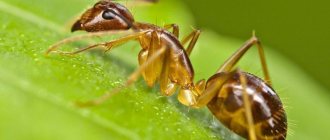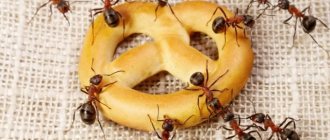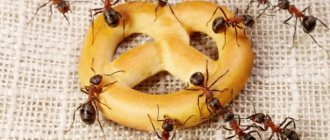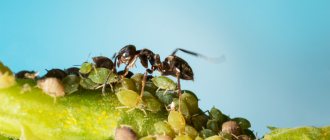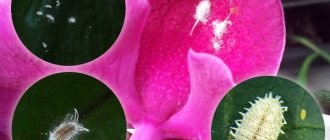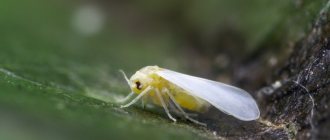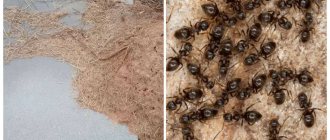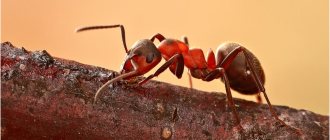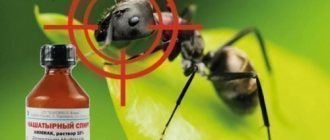A colony of ants in a garden bed is a dubious joy for a gardener, and the appearance of such newcomers in a greenhouse is a double disappointment. After all, in a place where the most comfortable conditions have been created that protect plants from the vagaries of weather and diseases, the last thing I would like to see is “neighbors” causing damage to the harvest. We tell you what folk methods will help drive ants out of the greenhouse.
Why do ants appear?
Getting rid of ants is difficult, especially if you don’t know the reason for their appearance. They mainly appear for the following reasons:
- When there is an anthill next to the greenhouse. For them, the greenhouse is a kind of “farm”, in which they grow aphids. For this reason, before installing a greenhouse, it is necessary to carefully study the selected area. It is also necessary to constantly treat the plants in the greenhouse so that aphids do not appear on them;
- Sometimes anthills appear in an already built greenhouse. They love to nest in a polycarbonate heifer, as ideal conditions for their life are created there: loose soil, lush greenery and protection from temperature changes. Usually, before the appearance of a nest, individual individuals are “scouts” who study the area and determine the suitability of the territory for life; such individuals should be immediately destroyed or driven out;
- The greenhouse may contain plants that attract insects. In this case, it will be even more difficult to get rid of ants, so you just need to plant plants that repel insects along the walls of the greenhouse.
These are the main reasons why ants appear. Before dealing with them, it is necessary to determine the cause of their appearance, and try to eliminate it, and then deal with the problem.
Traps
If there are not too many black ants, you can try traps to combat them. The simplest and most common among summer residents is a bottle or jar with a funnel inserted into the neck. Jam, honey, sugar syrup are poured onto the bottom and a convenient “bridge” is made for the ants from the ground to the neck. When ants appear, such traps are placed in the beds. Insects crawl inside and cannot get out. This method is suitable if you need to reduce the number of pests. Of course, you can’t get rid of an entire colony of pests this way.
Not very convenient, but you can still use glue traps to remove ants from the greenhouse. An adhesive composition is applied to a paper or plastic base, which remains sticky for several days or weeks. Insects stick to it and die. There are also electronic traps, they kill with a weak discharge of current. But firstly, they need a constant power source. Secondly, when working with the ground, you can accidentally touch them and receive an unpleasant blow. Thirdly, this can kill all the insects in the greenhouse and destroy the eco-system. For the same reason, you should not use ultrasonic repellers to get rid of greenhouse ants.
What effect do ants have on plants?
Ants are important to nature and provide the following benefits:
- Destroy pests and their larvae, in particular spider mites;
- They loosen the soil, so that more oxygen begins to flow to the roots of plants;
- The waste from their vital activity is fertilizer for plants;
However, the harm from their presence overshadows all the benefits, since they:
- They destroy plant seeds, which is why seedlings do not germinate;
- They feed on sprouts;
- Aphids are bred on cultivated plants;
- They interfere with cultivating the beds and destroying weeds.
Thus, ants do more harm than good. Therefore, when they appear, it is necessary to take immediate action; if the anthill grows, it will be even more difficult to get rid of them.
Insect repellent
There are many plants whose aroma repels ants; with their help, you can prevent their appearance and preserve sprouts. Such plants do not harm either plants or insects, but at the same time they effectively fight them.
You can repel pests in a greenhouse by planting:
The aroma of these plants is quite strong, and it causes anxiety in insects, which is why they tend to quickly leave the given place. But before planting such plants, you need to make sure that no one in your household is allergic to them.
Rules for fighting ants
How to get rid of ants in a greenhouse forever? There are many ways to get rid of garden ants in a greenhouse, but sometimes they are ineffective, usually due to the fact that a person carried out the procedure incorrectly.
First of all, this is due to the fact that they do not eliminate the cause of their appearance or do not process all the nests. It is imperative to find all the places where they have built nests, this is important, since if you eliminate one nest and leave the others, the procedure will have no effect.
Also, the entire area must be cleared, especially from old wood, slate and similar things, as they attract pests, and it is under them that ants like to make their nests. Before carrying out the procedure, you should completely dig up the nests and destroy the uterus, this way you can get rid of the problem for a long time. After this, the dug area must be treated with chemicals or folk remedies.
If they have made a nest in the center of the garden bed and don’t want to dig up the soil, then you need to make holes and find passages so that the substances penetrate deep into the nest.
Advice from experienced gardeners
If you see ants on peppers in a greenhouse, then get ready to fight aphids.
The insects themselves practically do not use peppers for food, but use the plants as a platform for grazing aphids. The gardener will have to fight two enemies at the same time: ants and aphids. The most effective way is to use complex insecticides that have a detrimental effect on pests. If ants appear in a greenhouse with tomatoes, an aqueous solution of vinegar in a 1:1 ratio will help. It must be applied to the paths between the beds, as well as to the pegs and trellis posts that hold the crops. Ants cannot stand the smell of vinegar and after several treatments they will leave the greenhouse with tomatoes forever. This procedure is also recommended for use as a preventive measure against the appearance of ants in a greenhouse. Preventative treatments should be carried out every 7-10 days.
What to do with ants in cucumber seedlings? Indeed, ants feed on seeds and cucumber seedlings. The best way to get rid of insects is to use poisonous baits. The most effective and safe option is a mixture of brewer's yeast with honey, sugar or jam.
Source of the article: https://glav-dacha.ru/kak-izbavitsya-ot-muravev-v-teplice/
Remedies for getting rid of ants
You can get rid of ants using special chemicals, or you can prepare them yourself.
Specialized stores have a variety of pest control products that do not harm crop plants. But some remedies are effective, while others are of no use at all. The products are usually sold in powder, gel or crayon form.
The best means for getting rid of insects in a greenhouse are:
- Ant-eater;
- Muratsid;
- Grom-2;
- Ant;
- Diazinon.
These substances act very quickly and almost always cope with the problem. They must be used strictly according to the instructions indicated on the packaging.
Long-lasting gels are recommended for use before planting. Powders can be used at any time; they need to be scattered in places where pests accumulate. You need to add a little product, the layer should be no more than 40 mm. Gardeners recommend covering the bait with a thin layer of soil.
You can also fight ants with crayons; they are quite effective. Because these crayons emit a scent that repels ants. Thanks to this smell, the ants will leave the greenhouse for a long time.
Some types of drugs penetrate into the ants through the upper integument or with food, and affect the insect's intestines. Insects die from such products within 1-2 days. But such substances are dangerous not only for insects, they can also harm the human body, as they accumulate in ripe fruits.
Anthill in a greenhouse: how to get rid of it
Black garden ants usually infest the greenhouse. They are quite large and differ from their forest relatives not only in color, but also in their housing. Unlike forest redheads, they do not build a ground hill, but arrange a den underground. It can be of the same impressive size, with a large number of internal passages. Only a small hole is visible from the outside. So that the ants do not have time to build their lair in the greenhouse. the soil in it must be periodically dug up and loosened regularly.
If you find such a nest, you need to destroy it. If it is located near plants, you can try to carefully dig it out, being careful not to touch the roots. The soil with ants and their eggs should be put in a bag and taken away, preferably spilled with boiling water, or thrown into the fire to burn the pests.
If a nest is discovered after harvesting, it needs to be covered with quicklime, filled with water, and after a couple of days the ground must be dug up. You can repeat the procedure. You can simply pour boiling water over the area, wait a little and dig up the soil. To get rid of an anthill, you can mix vegetable oil and boiling water in equal proportions, add vinegar or essential oils. You can use sunflower oil left over after cooking. This solution is poured into the nest.
Another way is to dissolve two tablespoons of baking soda in two liters of boiling water and pour the mixture into the anthill. You can mix soda and sugar in equal proportions and fill the nest with the dry mixture.
It is not recommended to do this with plants growing in a greenhouse, because you can burn the roots of the plants.
In very rare cases, gardeners and gardeners suffer from an invasion of red wood ants into a greenhouse. The fact is that they settle only in forests, copses and other areas where there are trees, away from people. If they wander into the garden, it means, firstly, that your area is close to the forest, and secondly, you have more food for them than next to the anthill. What to do in this case? If the anthill is small, you can try moving it further away. This is a difficult and unpleasant matter. You need to dig the ant's nest at least a meter deep, carefully place it in a sealed bag and take it far away, where it is placed in a hole dug for it. There is no guarantee that you will not leave the queen in the same place: in this case, all the worker ants carried away will return back. If forest ants are too annoying in your garden, you can destroy the nest by digging it up and pouring boiling water, soda solution or boiling oil over it. Interfering in this way with the forest eco-system is not very good, it is an extreme measure. You can try to get rid of these ants using traditional methods, scaring them away from greenhouses and greenhouses.
Traditional methods for getting rid of ants in a greenhouse
Ants do not like strong odors, including the smell of tomato tops. When cutting off the lower shoots of tomatoes, you don’t have to throw them away, but spread them on the ground - this will scare away the ants.
You can use other “fragrant” methods to fight ants:
- wrap plant shoots or place garlic shoots in beds;
- • peel a few heads of garlic, chop them, leave them in a bucket of cold water for about a day and pour this infusion over the beds or paths along which ants walk;
- plant fragrant herbs and flowers: marigolds, oregano, mint, lavender, parsley, fennel, rosemary, etc.;
- Place rags and rags soaked in kerosene in the aisle between the beds (not on the ground with the plants!). You can also coat the inside of the greenhouse with a kerosene solution (4 tablespoons per 10 liters of water) on the wooden structures, glass or polycarbonate from which it is made. The main thing is not to pour kerosene into the soil and not to work immediately after processing in a greenhouse with the door closed;
- prepare a weak solution of ammonia (5 ml of ammonia per 5 liters of water) and spray all the plants with it, water it at the root, spill the soil in places where ants accumulate, you can pour it into the nest and cover it with a cloth to enhance the effect;
- ammonia is safe for cultivated plants, but it is important not to exceed the concentration so as not to burn tender shoots and leaves;
- dissolve 120 grams of dry mustard in 2 liters of water, leave for three days and spray the plants generously; you can also sprinkle dry mustard on ant paths;
- Under the plants, you can sprinkle ash, baking soda, cinnamon, coffee grounds, or ground pepper on the soil. Just don’t forget about this treatment, otherwise it will be very unpleasant to work in the greenhouse; these substances themselves are safe for plants, and the ash is also useful.
All of the above methods are aimed more at scaring away ants. If there is no nest in the greenhouse, then they can help destroy insects that crawl in from the outside. But if there are too many insects in the greenhouse, then pest control should be more active and preferably using chemicals.
Folk remedies for pest control
Chemicals do not have a local effect, no matter how the manufacturer claims otherwise. Harmful substances accumulate in the stems and in ripe fruits, and negatively affect the human body. For this reason, it is better to use folk remedies to control pests; they do not harm the human body and have a beneficial effect on cultivated plants.
To control pests, you can use the products that are available in every home:
- Garlic;
- Jam;
- Kerosene;
- Various aromatic herbs;
- Potato;
- Regular boiling water;
- Ammonia;
- Vinegar;
- Millet;
- Soda.
These substances fight pests as effectively as special chemicals, and they are harmless. They need to be used correctly, and it is also advisable to carry out preventive maintenance a couple of times a season.
Types of greenhouse ants
There are several varieties of ants that live in countryside villages, including greenhouses. Most often these are black garden, forest red, brown meadow and sometimes yellow ants. The harm from all of them is approximately the same - they eat the sprouts and seeds of young plants, destroy the root system of plantings, infest the greenhouse with aphids, and also bite painfully. Black ants are most often found in suburban gardens, which is why they are called “garden ants.”
Red forest
It is quite difficult to breed small red ants in a greenhouse. In most cases, they are forest dwellers and appear only in dachas located close to the forest. But they also prefer to settle and create colonies in residential buildings and apartments.
The best protection against small red ants is prevention. It is recommended to dissolve 5 g of baking soda in 1 liter of clean water, and then add 30 liters of linseed oil. This solution must be spilled onto the soil in the greenhouse. Treatment should be carried out 2 weeks before planting. This solution will force the pests to leave their nest.
Black garden
To eradicate black garden ants in a greenhouse, it is recommended to prepare a solution of 50 g of 9% vinegar and 50 g of any vegetable oil. Then pour this mixture over the areas where pests accumulate. They will quickly leave the greenhouse. Black ants are considered the most common species on the planet, but in a greenhouse they need to be distinguished from the harvester ant, which is larger.
Yellow pharaohs
It is quite difficult to drive yellow ants out of a greenhouse. They prefer to parasitize in people's homes and other outbuildings. Such pests are also called pharaoh ants, as they were first discovered in the crypts of Egypt. Within human homes, they organize large nests that are connected to each other. They are difficult to destroy because if one nest is eradicated, its inhabitants will simply move to a new one. It is recommended to treat all areas with Grom-2. The product must be spread in places where pests accumulate.
Killing ants with garlic
Garlic is an effective and cheap pest control product.
You need to use it as follows:
- You need to grate the garlic and mix it with sawdust. The amount of garlic depends on the area of the plot and the size of the anthill;
- You need to fill the nests with sawdust and garlic;
You can also use garlic in another way:
- Grated garlic should be soaked in water and allowed to brew for 24 hours;
- After this, the infusion should be poured over the passages of the anthill, where there is a particularly large concentration of ants;
You need to use garlic at least three times to get rid of insects.
Repelling ants with herbs
Ants are considered susceptible to the strong odors that some plants emit. This property is used to drive insects out of the greenhouse. Suitable for “aroma fighting”:
- mint;
- sagebrush;
- carnation;
- garlic;
- mustard.
Herbs are laid out between greenhouse plants. Ants especially do not like the smell of garlic. It is recommended to grind it, add it to sawdust and sprinkle the mixture near the entrance to the anthill. An infusion made from a head of garlic and a bucket of water is more effective. After keeping the mixture for a day, it is watered where insects are active.
The disadvantage of this method is that the ants will simply change their location, but after a while they can return again.
Getting rid of insects with jam
Surprisingly, you can use jam to fight insects. Sweets attract insects, so you can lure them into a trap with the help of jam. To do this, you need to pour jam into the container; you can use a plastic bottle with the top cut off. The container with jam should be left next to the anthill for a couple of days, after which the stuck insects should be poured with boiling water.
This method will not help get rid of a large anthill; it can be used to get rid of scout ants and prevent the appearance of anthills.
Where did they even come from?
If ants appeared in a greenhouse, there could be three reasons: The insects went their own way and turned into the greenhouse to investigate. The important thing here is to simply kick them out in time. A new nest has appeared on your site, and pests go to the greenhouse to grow aphids there - it’s more convenient.
Just get rid of the aphids and scatter the cut garlic cloves over the beds. The nest appeared right inside the greenhouse, by digging from outside. It’s not so easy to find - you won’t see any anthill, it’s just a small hole, under which, however, a whole kingdom is already being built. Search and destroy.
First of all, figure out what kind of enemy wandered into your greenhouse. Thus, in Russia the following types of ants are most often found: Black garden ants. Red forest ones. Brown meadows. If your site is located near a forest, expect red insects to visit you, but they usually avoid the greenhouse.
But closed, warm soil is more attractive to black garden ants, which brazenly build their nests right in the beds. And with our multiple passages underground, we disrupt the root system of everything that grows in the greenhouse, which is why we may not get a harvest.
At the same time, black ants feed on plant seeds and seedlings. But if you meet one of these comrades, proceed very carefully:
Killing insects with kerosene
Kerosene allows you to quickly remove ants; it should be used as follows:
- Kerosene must be diluted with water, for this you need to take 2 tsp. kerosene and add it to a bucket of water at room temperature;
- The mixture must be poured into a sprayer and the ant nest and their paths must be treated;
In order to consolidate the result, the procedure should be repeated after a couple of days.
Hunting the Queen Ant
But why does it often happen that after serious chemical treatment, ants disappear for a while and then appear again? The fact is that any pesticides kill only adult insects, while the female continues to actively produce offspring.
The Queen always hides in the depths of the galleries; she cannot be found manually. Therefore, scientists today have developed a more cunning and sophisticated method: to make the ants themselves take the poison to their queen. If she dies, the anthill will also spread.
With fire, boiling water and poisons, we mainly destroy working ants, but they are replaced by new ones. You can only catch a queen and drones by surprise by accident, on a warm sunny day after a cool night, when this retinue comes out to warm up. Then you can pour boiling water over it.
If the poison that you left for the ants acts quickly, they will never carry it to their queen. But if the effect is weak, unnoticeable, the queen will be given such a delicacy, and over time it will kill her. To prepare such bait, make a regular sweet 1% boric acid solution, soak cotton wool in it and throw it into a jar.
Cover it so that ants can get in. They will bite off pieces of cotton wool and bring it to the queen with the drones. Every two weeks, update the contents of the jar, gradually reducing the concentration of the solution to 0.5%. In just a month and a half, the anthill will be completely destroyed.
Here is one such method: mix honey with dry boric acid in a 2:1 ratio, add a couple of drops of water and bring the mixture to the consistency of sour cream. We place bait on the ant paths and wait for someone to deliver this “treat” to their queen.
When boric acid gets inside an insect, it first causes severe itching and then kills it. On such paths, you can additionally sprinkle the poison “Bazudina”, which comes in granules that look like pupae. The ants themselves bring it into their home.
Using Potatoes
Potato peelings can be used to repel ants, as ants do not digest starch.
To do this, you just need to scatter potato peelings or chopped root vegetables on the site all season long. They will repel ants and anthills will not appear in the greenhouse area.
What to do
There are many methods that can help if there are ants in the greenhouse. The effectiveness of these methods varies, but from them each gardener will be able to choose the most suitable one for his garden.
All these methods can be divided into a number of groups:
- Physical.
- Chemical.
- Combined.
- Industrial pesticides.
Let's take a closer look at each of these methods.
Physical
First of all, you need to find places that ant families have chosen for themselves. These insects love to settle under old boards, sheets of slate or roofing felt lying on the ground, as well as in the wooden structures of greenhouses and greenhouses themselves, especially if the wood is rotten.
Thus, if you remove wood from greenhouses, thereby depriving insects of comfortable living conditions, you can reduce their colony.
Before you start planting, you can spill the entire soil with an aqueous solution of soda and linseed oil (5 g of soda and 30 g of linseed oil per 1 liter of water), which will force the ants to leave the greenhouse.
If you are willing to spend the time and effort to excavate in your own greenhouse, you can dig up the ants' nest and find the queen. By destroying it, you will destroy the entire settlement.
Deep digging of the soil in the greenhouse in the fall and spring, as well as frequent loosening of the soil in the summer months and regular sprinkling of discovered anthills and tunnels with ash, baking soda or quicklime will lead to the colony leaving the territory.
Using Vinegar and Soda
Baking soda is a universal remedy that will help get rid of many problems. You need to use a small amount of soda, then it will not harm the earth. You can use soda as follows:
- 2 tbsp. soda must be diluted with two liters of boiling water. The soda must be stirred well, and after that, pour it all into the anthill, pour it directly into the passages. The treated areas must be covered with earth or covered with dense material to prevent oxygen from entering;
- Baking soda can also be used in dry form by mixing it with powdered sugar. The ants will mistake the mixture for food because of the sweet aroma and the soda will kill them;
- You can also use a mixture of baking soda and vinegar to get rid of pests. To use this mixture, you need to make a small depression in the anthill and pour soda into it. Vinegar should be poured on top of the soda, after the reaction has passed, the crater should be covered with earth.
As you can see, soda can be used in any form; it will help get rid of insects, even if you just sprinkle it around the anthill. However, it will act for a long time, so it is better to use the methods described above, they act faster.
The benefits and harms of ants
Despite the obvious benefits, proximity to these hardworking insects in a greenhouse does a lot of harm to crops:
- Increased soil acidity, which is detrimental to some garden crops.
- Destruction of young shoots and fruits of plants with high fructose content.
- Inhibition of the root system of seedlings, which suffers due to the construction of an anthill.
- Increased incidence of diseases in greenhouse plants, because insects are carriers of various diseases.
In addition, sooner or later a colony of aphids will appear in a greenhouse with an anthill. These insects, which are harmless to humans, suck the juices out of plants in a short time, which leads to their deformation and death. The habitat of ants is usually not limited to the greenhouse. That is why they can introduce weed seeds from outside, which quickly multiply in the favorable microclimate of the greenhouse.
Baits based on boric acid for use in the garden
It would seem that seemingly harmless ants that appear on a personal plot should not cause much trouble. However, insects can attract huge swarms of aphids, which damage garden and vegetable plants.
Before you start fighting ants in the garden, locate the anthills. This way you will know for sure where to place the bait. Do not worry that boric acid will negatively affect garden crops; on the contrary, the effect of the substance enhances plant growth and performs an additional function as a fertilizer.
Corn mixture
Cornmeal itself is already destructive for the ant. Attracted by the aroma of the corn delicacy, ants eat the product, which greatly swells in the digestive tract and causes fatal injuries.
To enhance the effect, you can add a little boric acid to the product. Prepare the required volume of poisoned mixture at the rate of 100 g of corn flour per 10 g of powder, and scatter along the ant paths and around the anthill. Please note that the procedure should be performed as often as possible, at least once every 2 days. Otherwise, the product will not work due to high humidity and the influence of various physical phenomena.
Potato-egg bait
Although there is always something to eat in the garden, ants are still attracted to additional aromatic foods.
Boil a few potatoes and 2 hard-boiled eggs. Mash the boiled potatoes and yolks with a fork and mix. Also add 2 tbsp to the mixture. spoons of sugar and 20 g of boric acid powder. Make balls and place them around the ant nests. Renew the bait about once a week. After 14-20 days you will notice that there are fewer insects in the garden.
Wood ash mixture
To make bait you will need wood ash. You can buy it ready-made at a hardware store or simply take the remains of burnt firewood after cooking a barbecue or from the oven.
For 1 kg of ash you will need 3 ten-gram bags of powder. Mix the ingredients and sprinkle directly onto the anthill. The effect will be enhanced if there is light rain after the procedure, and the poison will penetrate deep into the nest.
Sweet, effective bait
One of the most effective means in the fight against ants are sugar baits, since insects are very greedy for sweets. To prepare dry poison you will need:
- powdered sugar;
- soda;
- rice flour;
- boric acid powder.
Combine the ingredients in equal proportions and scatter on the anthill. The product is destructive to ants not only because of its toxic effect, but also due to the rice flour, which greatly swells in the insect’s digestive system and causes irreparable damage. Powdered sugar acts as bait, the grains of which are very small and are easily carried by foraging ants into their nests.
Safety rules when using boric acid
Although boric acid is considered safe for humans, be sure to follow safety precautions when using it.
- Do not come into contact with the substance without gloves.
- Protect the respiratory tract with a cotton-gauze bandage.
- For mixing, choose either unnecessary dishes that you can simply throw away, or glass or ceramic ones that are not affected by chemical reactions. After all manipulations, wash the used container thoroughly.
- If you place baits on napkins, paper or plastic covers, discard them after use.
- When using boric acid in the garden, bury the remaining poison deep into the soil.
- If children or pets live in the house, choose inaccessible places to place baits. If a pet or even a child eats one ball of poisoned bait, most likely nothing bad will happen. With systematic use of the substance, severe poisoning of the body is possible.
Advantages of using boric acid
As a poison against ants, boric acid shows itself in the best possible way. The advantages of the product include:
- Low cost. For one dose of boric acid powder or solution you will spend about 50 rubles, and you can buy the substance at any pharmacy.
- Variety of applications. Boric acid can be used not only in its pure form to kill ants, but also as bait. This way the effectiveness of the product increases significantly.
- High quality result. Almost everyone who has used boric acid as a poison for ants notes the excellent effectiveness of the product and the complete destruction of colonies.
- Fast action. Once the poison enters the organ systems, irreversible intoxication and paralysis occur.
- Suitable for use both in an apartment or house, and on a personal plot.
- When used in the garden, it has a positive effect on plant growth, acting as a top dressing.
What is the danger
We all remember that these insects are capable of bringing benefits and they really do. After all, they are capable of destroying small pests that are quite dangerous for garden crops, for example, aphids and spider mites.
They also loosen the soil well when they build nests, which saturates the root system of plants with oxygen. The waste products of ants contain potassium and nitrogen, which significantly improves the quality of the soil.
But that's where the good news ends, replaced by the truth about the harm they cause. They are capable of destroying seeds after planting, so the owners simply cannot wait for the seedlings.
They are very fond of young, succulent plant sprouts, which leads to their death at the growth stage. They are able to create colonies of aphids, which they use as a source of sugar necessary for normal life.
They inflict very painful bites on people and animals. When they bite, they release formic acid, which can cause allergic reactions.
